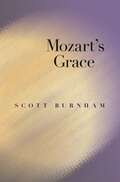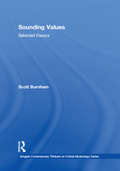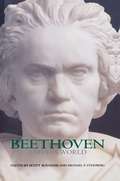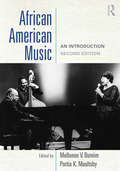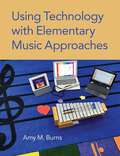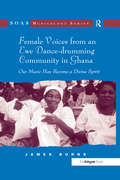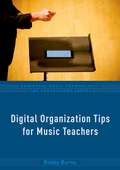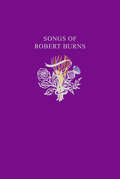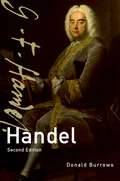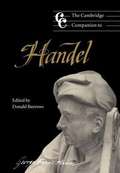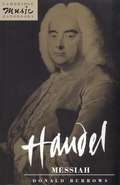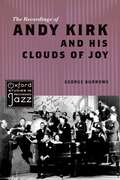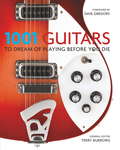- Table View
- List View
Mozart's Grace
by Scott BurnhamIt is a common article of faith that Mozart composed the most beautiful music we can know. But few of us ask why. Why does the beautiful in Mozart stand apart, as though untouched by human hands? At the same time, why does it inspire intimacy rather than distant admiration, love rather than awe? And how does Mozart's music create and sustain its buoyant and ever-renewable effects? In Mozart's Grace, Scott Burnham probes a treasury of passages from many different genres of Mozart's music, listening always for the qualities of Mozartean beauty: beauty held in suspension; beauty placed in motion; beauty as the uncanny threshold of another dimension, whether inwardly profound or outwardly transcendent; and beauty as a time-stopping, weightless suffusion that comes on like an act of grace. Throughout the book, Burnham engages musical issues such as sonority, texture, line, harmony, dissonance, and timing, and aspects of large-scale form such as thematic returns, retransitions, and endings. Vividly describing a range of musical effects, Burnham connects the ways and means of Mozart's music to other domains of human significance, including expression, intimation, interiority, innocence, melancholy, irony, and renewal. We follow Mozart from grace to grace, and discover what his music can teach us about beauty and its relation to the human spirit. The result is a newly inflected view of our perennial attraction to Mozart's music, presented in a way that will speak to musicians and music lovers alike.
Sounding Values: Selected Essays (Ashgate Contemporary Thinkers on Critical Musicology Series)
by Scott BurnhamFor several decades, Scott Burnham has sought to bring a ready ear and plenty of humanistic warmth to musicological inquiry. Sounding Values features eighteen of his essays on mainstream Western music, music theory, aesthetics and criticism. In these writings, Burnham listens for the values-aesthetic, ethical, intellectual-of those who have created influential discourse about music, while also listening for the values of the music for which that discourse has been generated. The first half of the volume confronts pressing issues of historical theory and aesthetics, including intellectual models of tonal theory, leading concepts of sonata form, translations of music into poetic meaning, and recent rifts and rapprochements between criticism and analysis. The essays in the second half can be read as a series of critical appreciations, engaging some of the most consequential reception tropes of the past two centuries: Haydn and humor, Mozart and beauty, Beethoven and the sublime, Schubert and memory.
Sounding Values: Selected Essays (Ashgate Contemporary Thinkers on Critical Musicology Series)
by Scott BurnhamFor several decades, Scott Burnham has sought to bring a ready ear and plenty of humanistic warmth to musicological inquiry. Sounding Values features eighteen of his essays on mainstream Western music, music theory, aesthetics and criticism. In these writings, Burnham listens for the values-aesthetic, ethical, intellectual-of those who have created influential discourse about music, while also listening for the values of the music for which that discourse has been generated. The first half of the volume confronts pressing issues of historical theory and aesthetics, including intellectual models of tonal theory, leading concepts of sonata form, translations of music into poetic meaning, and recent rifts and rapprochements between criticism and analysis. The essays in the second half can be read as a series of critical appreciations, engaging some of the most consequential reception tropes of the past two centuries: Haydn and humor, Mozart and beauty, Beethoven and the sublime, Schubert and memory.
Beethoven and His World (The Bard Music Festival #48)
by Scott Burnham Michael P. SteinbergFew composers even begin to approach Beethoven's pervasive presence in modern Western culture, from the concert hall to the comic strip. Edited by a cultural historian and a music theorist, Beethoven and His World gathers eminent scholars from several disciplines who collectively speak to the range of Beethoven's importance and of our perennial fascination with him. The contributors address Beethoven's musical works and their cultural contexts. Reinhold Brinkmann explores the post-revolutionary context of Beethoven's "Eroica" Symphony, while Lewis Lockwood establishes a typology of heroism in works like Fidelio. Elaine Sisman, Nicholas Marston, and Glenn Stanley discuss issues of temporality, memory, and voice in works at the threshold of Beethoven's late style, such as An die Ferne Geliebte, the Cello Sonata op. 102, no. 1, and the somewhat later Piano Sonata op. 109. Peering behind the scenes into Beethoven's workshop, Tilman Skowroneck explains how the young Beethoven chose his pianos, and William Kinderman shows Beethoven in the process of sketching and revising his compositions. The volume concludes with four essays engaging the broader question of reception of Beethoven's impact on his world and ours. Christopher Gibbs' study of Beethoven's funeral and its aftermath features documentary material appearing in English for the first time; art historian Alessandra Comini offers an illustrated discussion of Beethoven's ubiquitous and iconic frown; Sanna Pederson takes up the theme of masculinity in critical representations of Beethoven; and Leon Botstein examines the aesthetics and politics of hearing extramusical narratives and plots in Beethoven's music. Bringing together varied and fresh approaches to the West's most celebrated composer, this collection of essays provides music lovers with an enriched understanding of Beethoven--as man, musician, and phenomenon.
African American Music: An Introduction
by Mellonee V. Burnim Portia K. MaultsbyAmerican Music: An Introduction, Second Edition is a collection of seventeen essays surveying major African American musical genres, both sacred and secular, from slavery to the present. With contributions by leading scholars in the field, the work brings together analyses of African American music based on ethnographic fieldwork, which privileges the voices of the music-makers themselves, woven into a richly textured mosaic of history and culture. At the same time, it incorporates musical treatments that bring clarity to the structural, melodic, and rhythmic characteristics that both distinguish and unify African American music. The second edition has been substantially revised and updated, and includes new essays on African and African American musical continuities, African-derived instrument construction and performance practice, techno, and quartet traditions. Musical transcriptions, photographs, illustrations, and a new audio CD bring the music to life.
African American Music: An Introduction
by Mellonee V. Burnim Portia K. MaultsbyAmerican Music: An Introduction, Second Edition is a collection of seventeen essays surveying major African American musical genres, both sacred and secular, from slavery to the present. With contributions by leading scholars in the field, the work brings together analyses of African American music based on ethnographic fieldwork, which privileges the voices of the music-makers themselves, woven into a richly textured mosaic of history and culture. At the same time, it incorporates musical treatments that bring clarity to the structural, melodic, and rhythmic characteristics that both distinguish and unify African American music. The second edition has been substantially revised and updated, and includes new essays on African and African American musical continuities, African-derived instrument construction and performance practice, techno, and quartet traditions. Musical transcriptions, photographs, illustrations, and a new audio CD bring the music to life.
USING TECH ELEMENTARY MUSIC APPROACHES C
by Amy M. BurnsDo you find it challenging to integrate technology into your elementary music classroom? Do you feel that it could enhance your classroom experience if you could implement it in an approachable and realistic way? In Using Technology with Elementary Music Approaches, author Amy M. Burns offers an all-in-one, classroom-vetted guide to integrate technology into the music classroom while keeping with core educational strategies. In this book, you will find practical lessons and ideas that can be used in any elementary classroom, whether that classroom has one device per educator or a device for every student. Written for a range of experience levels, lessons further enhance classrooms that utilize the approaches of Feierabend, Kodály, Orff Schulwerk, and project-based learning. Experts from each field-Dr. Missy Strong, Glennis Patterson, Ardith Collins, and Cherie Herring-offer a variety of approaches and project ideas in the project-based learning section. Complemented by a companion website of lesson videos, resource guides, and more, Using Technology with Elementary Music Approaches allows new and veteran educators to hit the ground running on the first day of school.
Using Technology with Elementary Music Approaches
by Amy M. BurnsDo you find it challenging to integrate technology into your elementary music classroom? Do you feel that it could enhance your classroom experience if you could implement it in an approachable and realistic way? In Using Technology with Elementary Music Approaches, author Amy M. Burns offers an all-in-one, classroom-vetted guide to integrate technology into the music classroom while keeping with core educational strategies. In this book, you will find practical lessons and ideas that can be used in any elementary classroom, whether that classroom has one device per educator or a device for every student. Written for a range of experience levels, lessons further enhance classrooms that utilize the approaches of Feierabend, Kodály, Orff Schulwerk, and project-based learning. Experts from each field-Dr. Missy Strong, Glennis Patterson, Ardith Collins, and Cherie Herring-offer a variety of approaches and project ideas in the project-based learning section. Complemented by a companion website of lesson videos, resource guides, and more, Using Technology with Elementary Music Approaches allows new and veteran educators to hit the ground running on the first day of school.
Female Voices from an Ewe Dance-drumming Community in Ghana: Our Music Has Become a Divine Spirit
by James BurnsEwe dance-drumming has been extensively studied throughout the history of ethnomusicology, but up to now there has not been a single study that addresses Ewe female musicians. James Burns redresses this deficiency through a detailed ethnography of a group of female musicians from the Dzigbordi community dance-drumming club from the rural town of Dzodze, located in South-Eastern Ghana. Dzigbordi was specifically chosen because of the author's long association with the group members, and because it is part of a genre known as adekede, or female songs of redress, where women musicians critique gender relations in society. Burns uses audio and video interviews, recordings of rehearsals and performances and detailed collaborative analyses of song texts, dance routines and performance practice to address important methodological shifts in ethnomusicology that outline a more humanistic perspective of music cultures. This perspective encompasses the inter-linkages between history, social processes and individual creative artists. The voices of Dzigbordi women provide us not only with a more complete picture of Ewe music-making, they further allow us to better understand the relationship between culture, social life and individual creativity. The book will therefore appeal to those interested in African Studies, Gender Studies and Oral Literature, as well as ethnomusicology. Includes a DVD documentary.
Female Voices from an Ewe Dance-drumming Community in Ghana: Our Music Has Become a Divine Spirit
by James BurnsEwe dance-drumming has been extensively studied throughout the history of ethnomusicology, but up to now there has not been a single study that addresses Ewe female musicians. James Burns redresses this deficiency through a detailed ethnography of a group of female musicians from the Dzigbordi community dance-drumming club from the rural town of Dzodze, located in South-Eastern Ghana. Dzigbordi was specifically chosen because of the author's long association with the group members, and because it is part of a genre known as adekede, or female songs of redress, where women musicians critique gender relations in society. Burns uses audio and video interviews, recordings of rehearsals and performances and detailed collaborative analyses of song texts, dance routines and performance practice to address important methodological shifts in ethnomusicology that outline a more humanistic perspective of music cultures. This perspective encompasses the inter-linkages between history, social processes and individual creative artists. The voices of Dzigbordi women provide us not only with a more complete picture of Ewe music-making, they further allow us to better understand the relationship between culture, social life and individual creativity. The book will therefore appeal to those interested in African Studies, Gender Studies and Oral Literature, as well as ethnomusicology. Includes a DVD documentary.
The Pop Palimpsest: Intertextuality in Recorded Popular Music (Tracking Pop)
by Lori Burns Serge LacasseWithin popular music there are entire genres (jazz “standards”), styles (hip hop), techniques (sampling), and practices (covers) that rely heavily on references between music of different styles and genres. This interdisciplinary collection of essays covers a wide range of musical styles and artists to investigate intertextuality—the shaping of one text by another—in popular music. The Pop Palimpsest offers new methodologies and frameworks for the analysis of intertextuality in popular music, and provides new lenses for examining relationships between a variety of texts both musical and nonmusical. Enriched by perspectives from multiple subdisciplines, The Pop Palimpsest considers a broad range of intertextual relationships in popular music to explore creative practices and processes and the networks that intertextual practices create between artists and listeners.
Disruptive Divas: Feminism, Identity and Popular Music
by Lori Burns Melisse LafranceDisruptive Divas focuses on four female musicians: Tori Amos, Courtney Love, Me'Shell Ndegéocello and P. J. Harvey who have marked contemporary popular culture in unexpected ways have impelled and disturbed the boundaries of "acceptable" female musicianship.
Disruptive Divas: Feminism, Identity and Popular Music (Studies In Contemporary Music And Culture Ser.)
by Lori Burns Melisse LafranceDisruptive Divas focuses on four female musicians: Tori Amos, Courtney Love, Me'Shell Ndegéocello and P. J. Harvey who have marked contemporary popular culture in unexpected ways have impelled and disturbed the boundaries of "acceptable" female musicianship.
Dona Ivone Lara's Sorriso Negro (33 1/3 Brazil)
by Mila BurnsMore than simply a paragon of Brazilian samba, Dona (Lady) Ivone Lara's 1981 Sorriso Negro (translated to Black Smile) is an album deeply embedded in the political and social tensions of its time. Released less than two years after the Brazilian military dictatorship approved the Lei de Anistia (the "Opening" that put Brazil on a path toward democratic governance), Sorriso Negro reflects the seminal shifts occurring within Brazilian society as former exiles reinforced notions of civil rights and feminist thought in a nation under the iron hand of a military dictatorship that had been in place since 1964. By looking at one of the most important samba albums ever recorded (and one that also happened to be authored by a black woman), Mila Burns explores the pathbreaking career of Dona Ivone Lara, tracing the ways in which she navigated the tense gender and race relations of the samba universe to ultimately conquer the masculine world of samba composers.33 1/3 Global, a series related to but independent from 33 1/3, takes the format of the original series of short, music-basedbooks and brings the focus to music throughout the world. With initial volumes focusing on Japanese and Brazilian music, the series will also include volumes on the popular music of Australia/Oceania, Europe, Africa, the Middle East, and more.
Dona Ivone Lara's Sorriso Negro (33 1/3 Brazil)
by Mila BurnsMore than simply a paragon of Brazilian samba, Dona (Lady) Ivone Lara's 1981 Sorriso Negro (translated to Black Smile) is an album deeply embedded in the political and social tensions of its time. Released less than two years after the Brazilian military dictatorship approved the Lei de Anistia (the "Opening" that put Brazil on a path toward democratic governance), Sorriso Negro reflects the seminal shifts occurring within Brazilian society as former exiles reinforced notions of civil rights and feminist thought in a nation under the iron hand of a military dictatorship that had been in place since 1964. By looking at one of the most important samba albums ever recorded (and one that also happened to be authored by a black woman), Mila Burns explores the pathbreaking career of Dona Ivone Lara, tracing the ways in which she navigated the tense gender and race relations of the samba universe to ultimately conquer the masculine world of samba composers.33 1/3 Global, a series related to but independent from 33 1/3, takes the format of the original series of short, music-basedbooks and brings the focus to music throughout the world. With initial volumes focusing on Japanese and Brazilian music, the series will also include volumes on the popular music of Australia/Oceania, Europe, Africa, the Middle East, and more.
DIGITAL ORGANIZATION EMT C (Essential Music Technology: The Prestissimo Series)
by Robby BurnsAre you a music teacher searching for sanity in the midst of all your chaotic responsibilities? Music teachers have to do so much more than teach music. They have to be master musicians, educators, and conductors, all while balancing other professional disciplines like arranging, composing, trip planning, financing, and more. The parts of the job that take our sights off of great teaching must be managed so that we can focus on what counts: the music. If you are feeling overwhelmed by the logistics of your job, you are in luck- there is an app for that! Actually, a lot of apps. And Digital Organization Tips for Music Teachers is here to tell you all about them. Whether you can barely turn your computer on or if you are just looking for tips on how to make your work more efficient, there is something in store for you. The technologies in this book are presented in bite sized descriptions of desktop and mobile apps, followed by applications of how they can solve specific problems that music teachers experience every day. Each chapter covers a different type of data that music teachers have to organize, ranging from notes, to tasks, to scores and audio recordings.
Digital Organization Tips for Music Teachers (Essential Music Technology: The Prestissimo Series)
by Robby BurnsAre you a music teacher searching for sanity in the midst of all your chaotic responsibilities? Music teachers have to do so much more than teach music. They have to be master musicians, educators, and conductors, all while balancing other professional disciplines like arranging, composing, trip planning, financing, and more. The parts of the job that take our sights off of great teaching must be managed so that we can focus on what counts: the music. If you are feeling overwhelmed by the logistics of your job, you are in luck- there is an app for that! Actually, a lot of apps. And Digital Organization Tips for Music Teachers is here to tell you all about them. Whether you can barely turn your computer on or if you are just looking for tips on how to make your work more efficient, there is something in store for you. The technologies in this book are presented in bite sized descriptions of desktop and mobile apps, followed by applications of how they can solve specific problems that music teachers experience every day. Each chapter covers a different type of data that music teachers have to organize, ranging from notes, to tasks, to scores and audio recordings.
Robert Burns Songs: Selections From The Poems, Songs, And Ballads Of Robert Burns (Collins Scottish Archive)
by Robert BurnsA small format gift book which is a reproduction of the popular book ‘Songs Robert Burns’ originally published by Collins in 1947. Selected by G.F. Maine and written by burns between 1759 and 1796.
Handel (Master Musicians Series)
by Donald BurrowsHandel is one of the most remarkable figures in the history of western music. His compositions form one of the peaks of creative achievement in the Baroque period, and cover a remarkable range: full-scale Italian operas and English oratorios (including Messiah), but also shorter works such as the Water Music and the Coronation Anthem Zadok the Priest. His compositional processes were often complex, but could result in accessible and memorable 'hit tunes', such as the aria that subsequently became famous as 'Handel's Largo'. His life and career were as remarkable as his music. Born in Germany to a family that reputedly tried to discourage his initial interest in music, he broke away to seek his fortune in Italian opera, and proceeded to gain first-hand experience of the latest Italian styles in Rome, Florence, Venice and Naples. A series of career moves brought him via Hanover to London, where he eventually settled and dominated the city's musical life for half a century. There he quickly made his mark in English church music as well as Italian opera, and eventually created two new musical genres--English theatre oratorio and the organ concerto. Handel is important also because, as a musician, he also became a significant public figure. In Rome he attracted the patronage of princes and cardinals; soon after his arrival in London he appeared at the court of Queen Anne, and he subsequently enjoyed substantial support from the "Hanoverian" royal family. He survived turbulent periods in the musical and political life of London, reached a wider public through publications of his music, died a rich man and was buried in Westminster Abbey. This biography provides a comprehensive and balanced account of both the man and his music, drawing on the unusually rich legacy of documentary and musical sources from Handel's lifetime. This new edition of a book that has been recognized as a 'classic' biography of Handel, reliable on the factual details of the composer's life and comprehensive in the coverage of his music, incorporates a great deal of new material. The last half century has seen a great renewal of research on the circumstances of Handel's life, and a major expansion in performances and recordings of his music. The book brings together the results of this scholarly activity, and is informed by wide experience of modern performances of Handel's music, including the revival of his operas and experimentation with 'authentic' performance practices.
Handel (Master Musicians Series)
by Donald BurrowsHandel is one of the most remarkable figures in the history of western music. His compositions form one of the peaks of creative achievement in the Baroque period, and cover a remarkable range: full-scale Italian operas and English oratorios (including Messiah), but also shorter works such as the Water Music and the Coronation Anthem Zadok the Priest. His compositional processes were often complex, but could result in accessible and memorable 'hit tunes', such as the aria that subsequently became famous as 'Handel's Largo'. His life and career were as remarkable as his music. Born in Germany to a family that reputedly tried to discourage his initial interest in music, he broke away to seek his fortune in Italian opera, and proceeded to gain first-hand experience of the latest Italian styles in Rome, Florence, Venice and Naples. A series of career moves brought him via Hanover to London, where he eventually settled and dominated the city's musical life for half a century. There he quickly made his mark in English church music as well as Italian opera, and eventually created two new musical genres--English theatre oratorio and the organ concerto. Handel is important also because, as a musician, he also became a significant public figure. In Rome he attracted the patronage of princes and cardinals; soon after his arrival in London he appeared at the court of Queen Anne, and he subsequently enjoyed substantial support from the "Hanoverian" royal family. He survived turbulent periods in the musical and political life of London, reached a wider public through publications of his music, died a rich man and was buried in Westminster Abbey. This biography provides a comprehensive and balanced account of both the man and his music, drawing on the unusually rich legacy of documentary and musical sources from Handel's lifetime. This new edition of a book that has been recognized as a 'classic' biography of Handel, reliable on the factual details of the composer's life and comprehensive in the coverage of his music, incorporates a great deal of new material. The last half century has seen a great renewal of research on the circumstances of Handel's life, and a major expansion in performances and recordings of his music. The book brings together the results of this scholarly activity, and is informed by wide experience of modern performances of Handel's music, including the revival of his operas and experimentation with 'authentic' performance practices.
The Cambridge Companion To Handel (PDF)
by Donald Burrows Jonathan CrossHandel is recognised as one of the principal creative figures in Baroque music. In this Companion acknowledged experts on Handel make their expertise accessible to the interested general reader and music lover. All the genres in which Handel composed are considered including oratorio, chamber cantata, opera, and church music, as well as works for the keyboard and orchestra. The wide-ranging, specially-commissioned essays cover topics from Handel's composing methods to his treatment of the Italian language and matters of performance practice. The background to Handel's musical career is a major theme of the volume. The opening chapters deal with his musical education in Germany and the circumstances in Italy during his time there. Most of Handel's career was based in London and important topics here include contemporary concert life and theatre management, the British and Italian musicians among whom he worked, and the librettists for the English oratorios.
Handel: Messiah (Cambridge Music Handbooks) (PDF)
by Donald Burrows Julian RushtonThis new guide to Handel's most celebrated work traces the course of Messiah from Handel's initial musical response to the libretto, through the oratorio's turbulent first years to its eventual popularity with the Foundling Hospital performances. Different chapters consider the varying reception the work received in Dublin and London, the uneasy relationship between the composer and his librettist Charles Jennens and the many changes Messiah underwent through the varying needs and capacities of Handel's performers. As well as tracing the history of the work's development, the book addresses musical and technical issues such as Messiah's place in the oratorio genre, Handel's treatment of structural design, tonal relationships and English word-setting. An edited libretto elucidates the variants between the text that Handel set and the texts of the early printed word-books. Donald Burrows brings many new insights to this fascinating account of one of the favourite works of the concert hall.
RECORD ANDY KIRK & CLOUDS OF JOY OSRJ C (Oxford Studies in Recorded Jazz)
by George BurrowsAndy Kirk's Clouds of Joy came from Kansas City to find nationwide fame in the later 1930s. The many records they made between 1929 and 1949 came to exemplify the Kansas City style of jazz, but they were also criticized for their populism and inauthenticity. In The Recordings of Andy Kirk' and his Clouds of Joy, George Burrows considers these records as representing negotiations over racialized styles between black jazz musicians and the racist music industry during a vital period of popularity and change for American jazz. The book explores the way that these reformative negotiations shaped and can be heard in the recorded music. By comparing the band's appropriation of musical styles to the manipulation of masks in black forms of blackface performance--both signifying and subverting racist conceptions of black authenticity--it reveals how the dynamic between black musicians, their audiences and critics impacted upon jazz as a practice and conception.
The Recordings of Andy Kirk and his Clouds of Joy (Oxford Studies in Recorded Jazz)
by George BurrowsAndy Kirk's Clouds of Joy came from Kansas City to find nationwide fame in the later 1930s. The many records they made between 1929 and 1949 came to exemplify the Kansas City style of jazz, but they were also criticized for their populism and inauthenticity. In The Recordings of Andy Kirk' and his Clouds of Joy, George Burrows considers these records as representing negotiations over racialized styles between black jazz musicians and the racist music industry during a vital period of popularity and change for American jazz. The book explores the way that these reformative negotiations shaped and can be heard in the recorded music. By comparing the band's appropriation of musical styles to the manipulation of masks in black forms of blackface performance--both signifying and subverting racist conceptions of black authenticity--it reveals how the dynamic between black musicians, their audiences and critics impacted upon jazz as a practice and conception.
1001 Guitars to Dream of Playing Before You Die (1001)
by Terry BurrowsFind out why Chet Atkins had a Gretsch guitar named after him, why The Who's John Entwistle called his favourite guitar "Frankenstein", and how John Lennon elevated the Rickenbacker 325 to one of the most desirable guitar brands of the 1960's.1001 Guitars to Dream of Playing Before Your Die showcases the greatest instruments from across the globe: some are of historical or cultural significance and some were made famous by well-known musicians; others are included as examples of technological breakthroughs, innovative design or extraordinary sound quality. From the earliest models produced by Belchior Dias in the sixteenth century to the latest Gibson "Robot" series of guitars with computer-controlled self-tuning capabilities and onboard sound-processing features, 1001 Guitars to Dream of Playing Before Your Die tells the fascinating stories behind the creation of each one.All the classic names are here - Fender, Roland, Martin, Gretsch and Rickenbacker - as well as important Japanise brands, such as Ibanez, Yamaha and Teisco; European classics of the 1960's including Burns, Hagstrom, Eko and Hofner; obscure models from behind the "Iron Curtain", such as Defil, Aelita, Resonet and Musima; and present-day oil-can guitars built in South Africa. Never before have so many guitars been profiled within a single illustrated volume.A striking colour photograph of each guitar is accompanied by specification details and illuminating text that traces the guitar's history and reveals which famous musicians like to play the instrument and on what albums it can be heard. Contents includes... IntroductionPre -1930s1930 - 1949 1950s1960s1970s1980s1990s2000s
